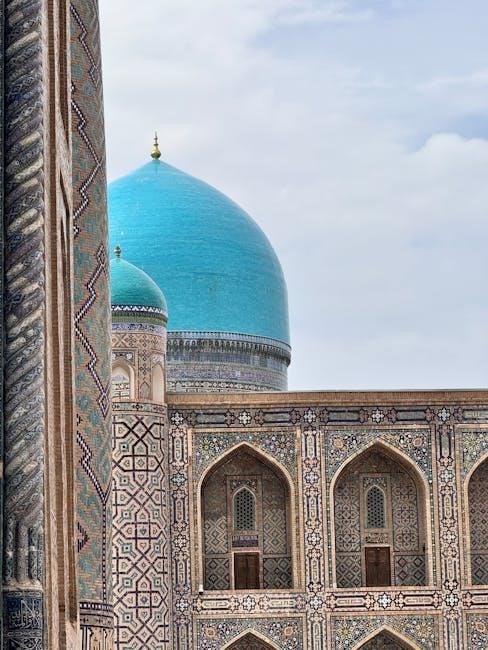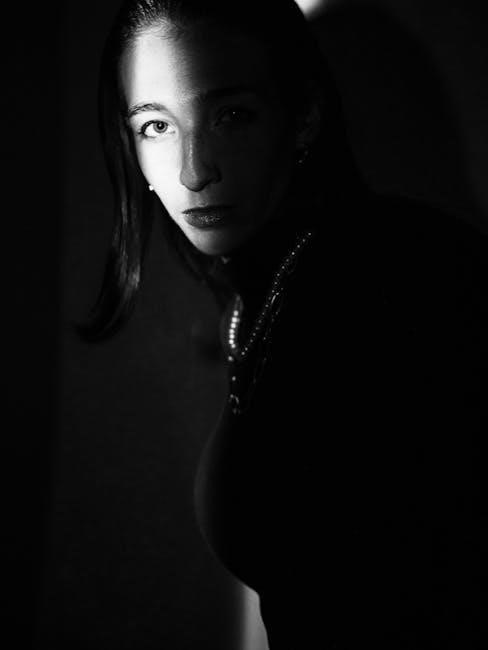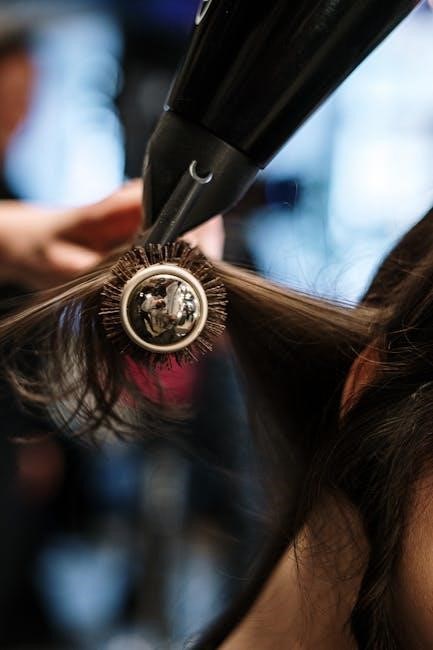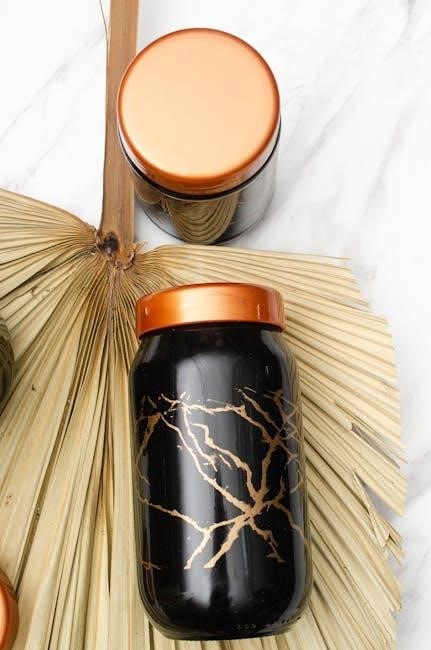Discover the Persian Tiles Crochet Pattern, a stunning blend of traditional motifs and modern techniques. This free PDF pattern offers a creative journey, combining vibrant colors and intricate geometric details to craft a breathtaking blanket. Perfect for intermediate crocheters, it’s a rewarding project that merges history and artistry.
Overview of the Persian Tiles Crochet Design
The Persian Tiles Crochet Design is a captivating pattern that blends traditional Persian motifs with modern crochet techniques. It features modular motifs, including octagons, squares, and triangles, which are worked individually and then seamlessly joined to create a stunning mosaic-inspired blanket. Known for its vibrant colors and intricate geometric details, this design offers a challenging yet rewarding project. Perfect for intermediate crocheters, it combines historical inspiration with artistic expression, resulting in a breathtaking composition that showcases both skill and creativity.
Historical Inspiration Behind Persian Tile Patterns
Persian tile patterns draw inspiration from ancient Persian architecture, particularly the intricate mosaics found in historic sites like Isfahan and Persepolis. These designs reflect a rich cultural heritage, blending Islamic geometric motifs with pre-Islamic Persian artistic traditions. The tiles were often used to adorn palaces, mosques, and public spaces, symbolizing prosperity and divine beauty. Modern crochet interpretations capture the essence of these timeless designs, translating their elegance into stitchwork that honors the artisans who first created them centuries ago.
Materials and Tools Needed
Gather medium-weight yarn, a size J (6.0mm) crochet hook, tapestry needle, scissors, stitch markers, and a measuring tape for the Persian Tiles Crochet Pattern.
Recommended Yarns for Persian Tiles
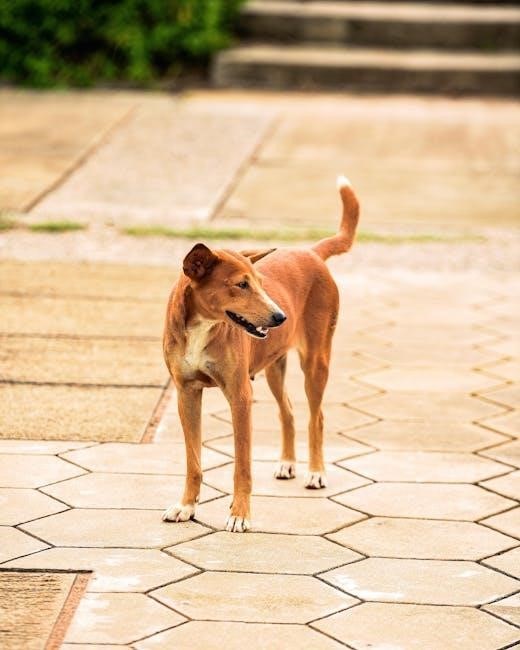
For the Persian Tiles Crochet Pattern, medium-weight yarns with excellent stitch definition are ideal. Acrylic yarns like Lion Brand Vanna’s Choice or Bernat Super Value work beautifully, offering softness and durability. Cotton blends, such as Peaches & Creme, provide a rustic charm and are breathable. Choose yarns with rich, vibrant colors to reflect the traditional Persian aesthetic. Consider the fiber content and texture to ensure the blanket drapes nicely. Always check the yarn weight and recommended hook size for the best results. This ensures your project will be both visually striking and long-lasting.
Crochet Hooks and Notions Required
For the Persian Tiles Crochet Pattern, use a US size H (5mm) or I (5.5mm) crochet hook, depending on your tension. Aluminum or steel hooks are ideal for maintaining stitch consistency. Essential notions include a tapestry needle for weaving ends, stitch markers for tracking motif connections, and scissors for cutting yarn. A measuring tape ensures accurate sizing, and a small yarn needle aids in sewing seams. These tools will help you achieve a polished and professional finish for your Persian Tiles project.
Color Palette Selection for Authentic Look
Selecting the right colors is crucial for achieving the authentic Persian Tiles look. Traditional Persian designs often feature deep blues, emerald greens, terracotta, and golden yellows, creating a vibrant yet harmonious palette. For a modern twist, consider adding neutral tones like cream or soft gray to balance the design. Use high-quality, medium-weight yarns with excellent stitch definition to ensure the intricate patterns stand out. Including a mix of contrasting and complementary colors will enhance the geometric beauty of the tiles, making your finished blanket truly eye-catching and authentic.
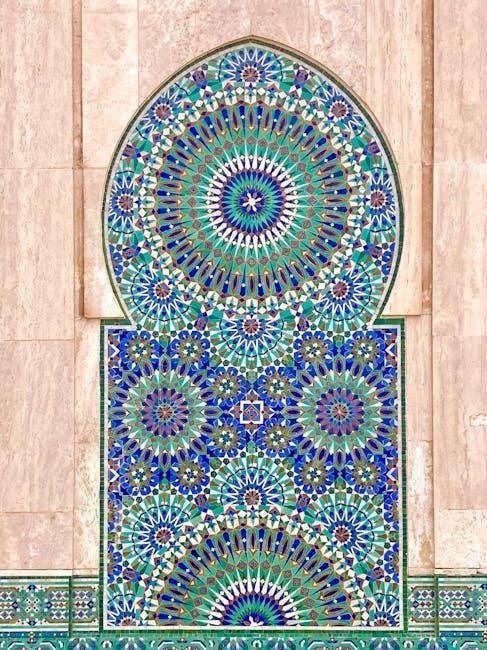
Understanding the Pattern
The Persian Tiles pattern involves modular motifs like octagons, squares, and triangles, which fit together to create a cohesive design. Geometric symmetry and intricate details are key elements, requiring attention to stitch placement and color changes. The pattern’s complexity makes it ideal for intermediate crocheters who enjoy intricate stitching and precise motif assembly.
Modular Motifs: Octagons, Squares, and Triangles
The Persian Tiles pattern features interchangeable motifs, including octagons, squares, and triangles, which interlock seamlessly to form a vibrant and intricate design. Each motif is crocheted separately, allowing for flexibility in color and placement. Octagons serve as the primary framework, while squares and triangles fill gaps, creating a balanced and symmetrical composition. This modular approach enables crafters to customize the project, making it adaptable to various sizes and personal style preferences. The interplay of shapes and colors highlights the pattern’s geometric beauty and cultural inspiration.
Importance of Geometric Symmetry and Intricate Details
Geometric symmetry is the backbone of the Persian Tiles crochet pattern, ensuring a visually appealing and balanced design. Intricate details, such as precise stitch placement and subtle color transitions, elevate the project from ordinary to extraordinary. These elements reflect the cultural heritage of Persian art, where symmetry and complexity are deeply revered. Achieving this level of detail requires patience and attention, but it rewards crafters with a masterpiece that exudes sophistication and craftsmanship, making every stitch worth the effort for a truly stunning result.
Step-by-Step Guide to Reading the Pattern
Understanding the Persian Tiles crochet pattern begins with deciphering its components. Start by reviewing the chart or written instructions, noting stitch repeats, rounds, and color changes. Pay attention to abbreviations and symbols, which are typically explained in a key. Break the pattern into manageable sections, focusing on one motif at a time. Practice stitches beforehand to ensure familiarity. Begin with a swatch to confirm gauge, then proceed to the full project. Use stitch markers to track progress and maintain pattern alignment. Follow the sequence carefully to achieve the desired geometric design.
Basic Crochet Stitches for Beginners
Master foundational stitches like chain, single crochet, and double crochet to create the Persian Tiles pattern. These stitches form the base of intricate tile designs.
Foundation Stitches: Chain, Single Crochet, and Double Crochet
The foundation stitches—chain, single crochet (sc), and double crochet (dc)—are essential for creating the Persian Tiles pattern. Begin with a chain stitch to set up your project. The single crochet stitch creates a smooth, dense fabric, while the double crochet adds height and texture. These stitches form the base for intricate tile designs. Practice them evenly to ensure a professional finish. Mastering these basics will make it easier to progress to more complex elements of the pattern, like fans and mandalas, ensuring a stunning final result.
Advanced Stitches: Fans and Mandalas
Fans and mandalas are advanced stitches that elevate the Persian Tiles pattern, adding intricate layers and visual interest. Fans create a flowing, multi-round design, while mandalas introduce complex, symmetrical motifs. These stitches require precision and patience but bring depth to the tiles. Practice them separately before integrating into your project. Use stitch markers to keep track of rounds and ensure proper alignment. Mastering these stitches enhances the pattern’s authenticity and appeal, making your finished project truly captivating.
Working in Rounds and Joining Techniques
Working in rounds is essential for creating the Persian Tiles pattern, as each motif is crocheted individually before being joined. Maintaining accurate stitch counts ensures symmetry. Joining techniques, like the “join-as-you-go” method, allow seamless connection of motifs, preserving the design’s geometric balance. Use stitch markers to track rounds and ensure proper alignment. Blocking each motif before joining helps achieve a polished finish. Mastering these techniques is key to crafting a cohesive and visually stunning blanket that reflects the traditional Persian aesthetic with modern crochet flair.
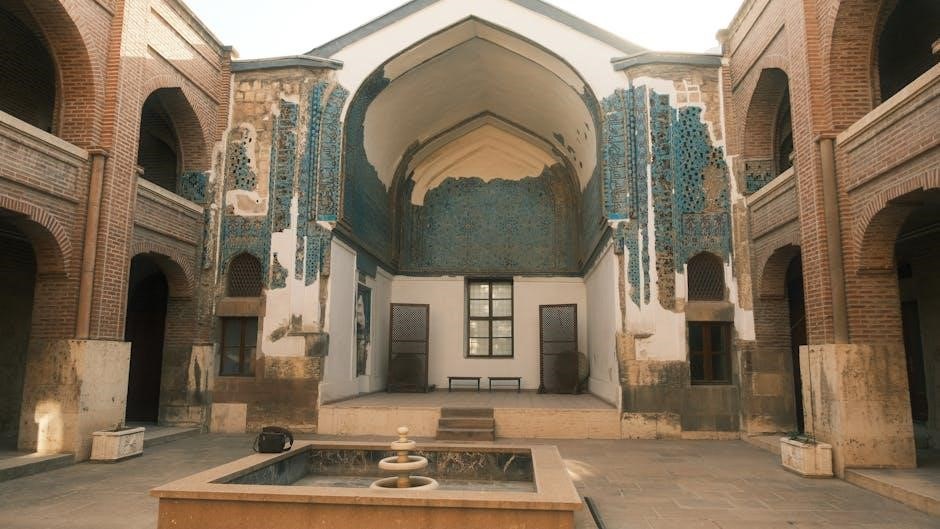
Design Elements and Aesthetics
The Persian Tiles crochet pattern combines vibrant colors and intricate geometric motifs, blending traditional Persian art with modern crochet techniques. Each tile features symmetrical patterns and detailed accents, creating a visually striking design that appeals to both experienced crocheters and newcomers. The interplay of colors and textures brings depth and elegance, making it a timeless and versatile project for home decor or personal use.
Blend of Traditional Persian Motifs with Modern Techniques
The Persian Tiles crochet pattern beautifully merges traditional Persian motifs, such as intricate floral patterns and geometric shapes, with contemporary crochet methods. By adapting ancient Persian art into crocheted form, the design maintains its cultural essence while offering a fresh, modern aesthetic. The use of modular motifs and vibrant color schemes allows crocheters to create timeless pieces that honor tradition yet appeal to today’s crafters. This fusion makes the pattern both historically inspiring and accessible for those seeking a unique, visually captivating project.
Vibrant Colors and Texture in Each Tile
The Persian Tiles crochet pattern shines with its use of vibrant colors and intricate textures, capturing the essence of traditional Persian art. Each tile is a canvas of rich hues and geometric patterns, creating a visually striking design. The texture is enhanced by the interplay of stitches, adding depth to the motifs. Crocheters can experiment with bold color combinations to achieve a modern yet culturally rich appearance, ensuring every tile is a masterpiece of both color and tactile beauty.
Creating a Breathtaking Composition
Creating a breathtaking composition with Persian Tiles involves meticulously arranging motifs to achieve harmony and balance. Start by planning the layout, ensuring symmetry and visual flow. Experiment with color gradients and geometric patterns to draw the eye across the design. Consider layering motifs in a central focal point, then expand outward for a cohesive look. Mixing large and small tiles adds depth, while maintaining consistent spacing ensures a polished finish; This approach transforms individual tiles into a stunning, unified masterpiece that captivates the viewer.
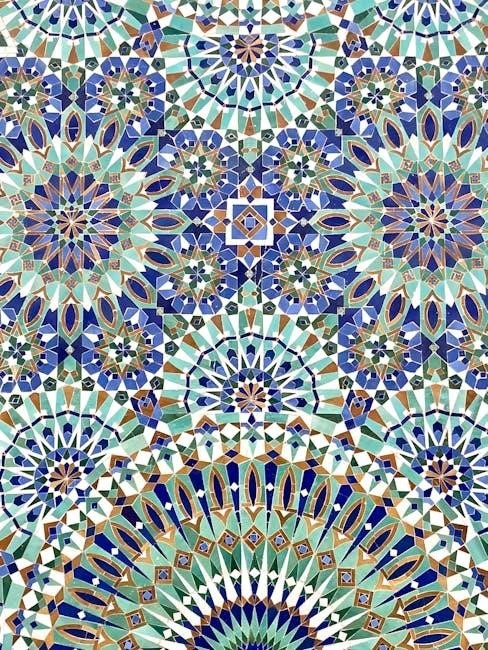
Step-by-Step Crochet Instructions
Follow the Persian Tiles Crochet Pattern PDF for detailed guidance. Start with the foundation motif, then build by joining tiles using slips or whipstitch. Use stitch markers to keep track of rounds and maintain tension for a professional finish. Refer to the included charts and written instructions for clarity. This pattern is perfect for intermediate crocheters looking to create a stunning, intricate design with a modern twist on traditional Persian aesthetics.
Octagon Motif Tutorial Using US Crochet Terms
Begin by creating a magic ring or starting with a chain-3 to form the center of the octagon. Work 8 single crochet stitches evenly around the ring, ensuring symmetry. For the first round, double crochet in each stitch, maintaining even tension. Gradually increase stitches in subsequent rounds to shape the octagon. Use stitch markers to mark increases and maintain pattern consistency. Count stitches carefully to avoid mismatches. This motif forms the foundation of the Persian Tiles pattern, blending traditional geometry with modern crochet techniques for a stunning result.
Assembling the Blanket: Joining Motifs Seamlessly
To assemble the blanket seamlessly, start by arranging the motifs in your desired layout. Use a tapestry needle to weave in all yarn ends. Join motifs using a slip stitch or whipstitch, aligning corresponding stitches carefully. Maintain even tension to prevent puckering. For a polished look, join motifs in rounds, working from the center outward. Use stitch markers to guide alignment. This method ensures a cohesive and professional finish, transforming individual motifs into a stunning Persian Tiles blanket.
Adding Borders and Edging for a Finished Look
Add a decorative border to enhance the beauty of your Persian Tiles blanket. Use simple single or double crochet stitches for a classic finish, or opt for a more intricate edging like the picot stitch for a traditional Persian touch. Ensure symmetry by aligning the border stitches with the motifs. Use stitch markers to maintain even spacing. Choose a border color that complements the palette, tying the design together. A well-crafted edging elevates the blanket, giving it a polished and professional appearance while preserving its cultural charm.
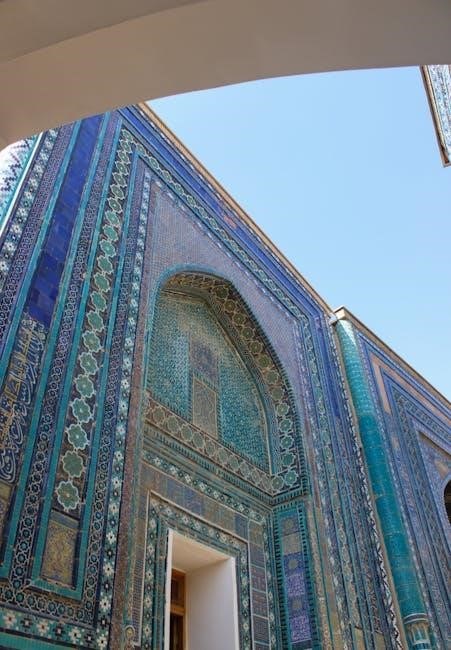
Free Resources and Patterns
Explore free Persian Tiles crochet patterns online. Websites like Moogly, The Crochet Crowd, and Etsy offer downloadable PDFs. Pinterest and Ravelry also feature community-shared designs.
Where to Find Free Persian Tiles Crochet Patterns
Discover free Persian Tiles crochet patterns on platforms like Ravelry, Pinterest, and Etsy. Many crochet communities and blogs offer downloadable PDFs. Websites such as Moogly and The Crochet Crowd frequently share free designs. Additionally, independent designers on Etsy provide free patterns for personal use. These resources include step-by-step instructions and color charts to create intricate tile designs. Always check the terms of use and give credit to the creators. These patterns are perfect for crafting custom blankets with a traditional Persian aesthetic.
Recommended Designers and Websites for Patterns
For high-quality Persian Tiles crochet patterns, explore designs from renowned crochet designers like Tamara from Moogly and The Crochet Crowd. Websites such as Etsy and Ravelry feature patterns from independent designers, often with detailed instructions. Fiber Flux and Yarnspirations also offer stunning Persian-inspired designs. Many designers provide free or paid PDFs, ensuring you find the perfect fit for your skill level. These platforms are trusted sources for intricate and authentic Persian Tile patterns, helping you create beautiful projects with ease.
Downloading the Persian Tiles Crochet Pattern PDF
Downloading the Persian Tiles Crochet Pattern PDF is a convenient way to access detailed instructions and charts. Many designers offer free or paid PDFs through platforms like Etsy, Ravelry, or Craftsy. Simply browse the marketplace, select your desired pattern, and follow the download link. Ensure the PDF includes step-by-step instructions, stitch diagrams, and color charts for accuracy. Once downloaded, save it to your device or print it for easy reference. This format allows you to work on your project seamlessly, with all information in one organized document.
Intermediate-Level Tips and Tricks
Mastering modular motifs and maintaining stitch consistency are key. Use stitch markers for complex patterns and swatch before starting. Block motifs to ensure symmetry and professional finish.
Mastering Modular Motifs for a Professional Finish
Mastering modular motifs requires precision and patience. Start by understanding the pattern’s repeating units, ensuring each motif is consistent in size and stitch count. Use stitch markers to keep track of increases and decreases. Block each motif before joining to achieve a polished look. Pay attention to yarn weight and hook size to maintain uniformity. Practice working in rounds and perfecting join-as-you-go techniques. This attention to detail will elevate your project, giving it a professional and cohesive appearance.
Managing Yarn Colors and Quantities Effectively
Effective yarn management ensures your Persian Tiles project remains organized. Begin by creating a color chart, mapping each motif’s yarn requirements. Measure yarn lengths for each color to avoid shortages. Use small containers or ziplock bags to store and label yarns by color. Track usage with a notebook or digital tool. For multi-color motifs, wind yarn into smaller balls to prevent tangles. Always have extra yarn on hand for consistency. Proper planning prevents mid-project delays and ensures a seamless crafting experience.
Troubleshooting Common Mistakes in the Pattern
Common mistakes in the Persian Tiles pattern often stem from miscounting stitches or misaligning motifs. To fix this, use stitch markers to track rounds and double-check motif alignment before joining. Incorrect hook sizes can skew dimensions; ensure gauge matches the pattern. Color placement errors can disrupt symmetry—refer to the color chart provided in the PDF. If a motif appears distorted, re-examine stitch tension and hook size consistency. Regularly frogging (ripping out) stitches early can prevent major corrections later. Patience and careful attention to detail yield the best results.
Finished Project Showcase
Admire the Persian Tiles crochet pattern’s beauty through stunning finished blankets. Explore vibrant colorways like Eastern Jewels and discover inspiring creations from crocheters worldwide, showcasing timeless elegance.
Eastern Jewels Colorway and Other Variations
The Eastern Jewels colorway captivates with its vibrant blend of deep blues, emerald greens, and golden hues, evoking the opulence of Persian art and architecture. This striking design creates a dazzling visual impact, perfect for crafting a standout blanket. Beyond Eastern Jewels, crocheters can explore other variations, such as soft pastel palettes for a bohemian vibe or neutral tones for a modern, minimalist aesthetic. Each variation maintains the intricate details and symmetry that define the Persian Tiles pattern, offering endless creativity for crafters.
Community Creations and User-Generated Projects
Crocheters worldwide have embraced the Persian Tiles pattern, showcasing their unique interpretations and creativity. Many share their finished projects on social media, inspiring others with personalized color schemes and innovative adaptations. From baby blankets to home decor, the community has transformed the pattern into diverse, meaningful pieces. These user-generated projects highlight the versatility of the design, fostering a sense of connection and pride among crafters. Seeing others’ work sparks new ideas, proving the Persian Tiles pattern’s timeless appeal and adaptability.
Inspiring Examples from Crochet Enthusiasts
Inspiring Examples from Crochet Enthusiasts
Crochet enthusiasts have created stunning interpretations of the Persian Tiles pattern, sharing their work online. From vibrant blankets to intricate pillow covers, these projects showcase incredible creativity. Many crafters experiment with unique color combinations, blending traditional inspiration with modern twists. Their work, often shared on platforms like Instagram and Pinterest, motivates others to explore the pattern. These inspiring examples demonstrate how the Persian Tiles design can be adapted to reflect personal style, encouraging crafters to push their creative boundaries and try new techniques.
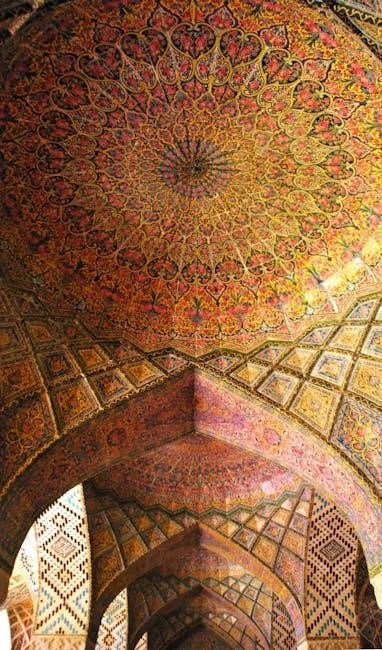
Care and Maintenance
Hand wash your Persian Tiles crochet project gently in cold water, reshape while damp, and air dry to preserve vibrant colors and texture.
Washing and Drying Instructions for Your Finished Blanket
To maintain the vibrant colors and intricate stitching of your Persian Tiles crochet blanket, hand wash it gently in cold water using a mild detergent. Avoid machine washing, as it may damage the fibers or cause shrinkage. Gently squeeze out excess water without wringing. Lay the blanket flat on a clean towel, reshape it to maintain the tile pattern, and allow it to air dry completely. Direct sunlight should be avoided to prevent fading. Proper care ensures your blanket remains a beautiful, cozy addition to your home for years.
Storing Your Crochet Project Properly
Properly storing your Persian Tiles crochet project ensures its longevity and preserves its vibrant colors and intricate details. Avoid direct sunlight to prevent fading and store the blanket in a cool, dry environment. Fold the blanket neatly or roll it to prevent creases, and place it in an airtight container or breathable fabric bag. Clean the blanket before storage to protect it from dust and moisture. For long-term storage, consider using acid-free tissue paper to prevent discoloration and maintain its pristine condition;
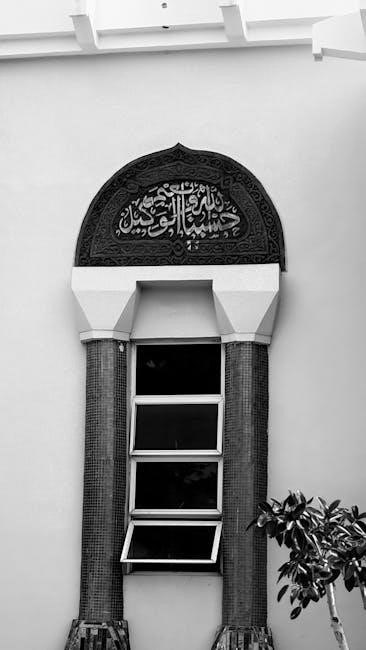
Crochet Community and Support
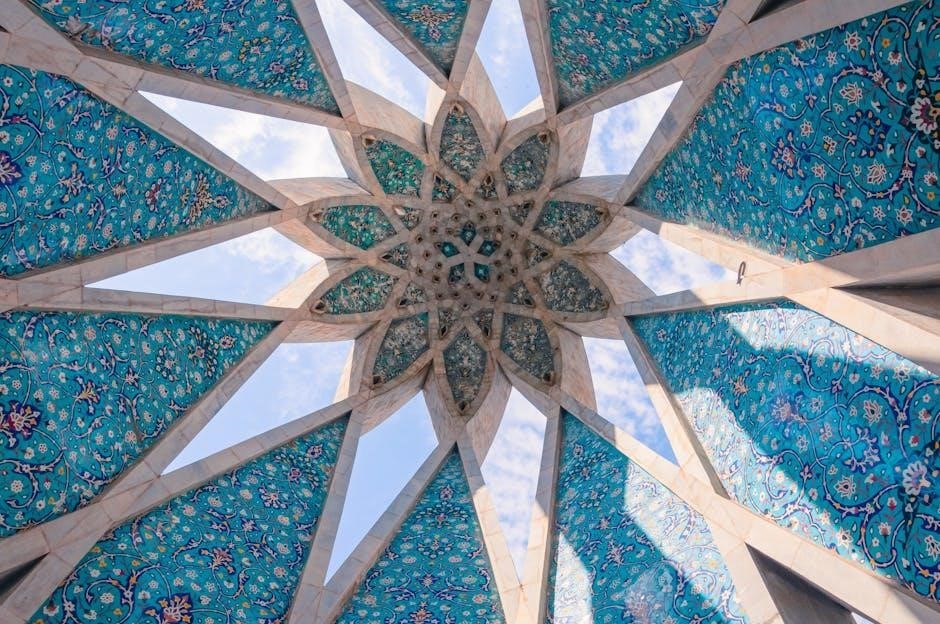
Join vibrant online forums and crochet groups for shared inspiration and advice. Attend virtual workshops and events to connect with fellow crafters and learn tips for the
Persian Tiles pattern. Engage with communities on social media platforms for support, motivation, and stunning project showcases that foster creativity and collaboration.
Online Forums and Groups for Persian Tiles Crochet
Joining online forums and crochet groups is an excellent way to connect with crafters passionate about the Persian Tiles pattern. Platforms like Facebook Groups, Ravelry, and Reddit host vibrant communities where you can share progress, seek advice, and inspire others. These spaces often feature tutorials, pattern reviews, and tips for mastering the design. Engaging with these groups can enhance your crochet journey and provide valuable resources for perfecting the Persian Tiles crochet pattern.
- Facebook Groups: Search for crochet-specific groups focused on cultural or geometric patterns.
- Ravelry: Explore forums and projects dedicated to Persian-inspired crochet designs.
- Reddit: Participate in subreddits like r/crochet for feedback and inspiration.
These communities are great for troubleshooting and staying motivated throughout your project.
Workshops and Events Featuring the Pattern
Crochet enthusiasts can explore workshops and events featuring the Persian Tiles pattern, offering hands-on learning experiences. These events, often hosted by crochet communities or yarn stores, provide guidance from experienced instructors. Participants learn to create intricate motifs and seamless joins. Many workshops include interactive sessions, allowing crafters to troubleshoot and refine their skills. Some events offer free resources, like the Persian Tiles Crochet Pattern PDF, to help attendees get started. These gatherings foster creativity and connections among crocheters, making them an excellent way to master the pattern and share ideas.
Completing the Persian Tiles Crochet Pattern brings immense satisfaction, blending traditional motifs with modern techniques. Each tile’s intricate beauty culminates in a stunning piece, showcasing your skill. Whether you’re a seasoned crafter or a beginner, this journey is rewarding and creatively fulfilling.
Final Thoughts on the Persian Tiles Crochet Pattern
Creating the Persian Tiles Crochet Pattern is a fulfilling journey that blends tradition with modern crochet techniques. Each motif represents a piece of cultural artistry, offering a sense of accomplishment with every completed tile. The pattern’s versatility allows crafters to adapt it into various projects, from blankets to pillow covers. The crochet community’s support and shared creations inspire continuous learning and growth. Embrace the challenge, enjoy the process, and take pride in your handmade masterpiece—a true testament to your skill and creativity.
Encouragement for Crafters of All Levels
Embarking on the Persian Tiles crochet pattern is a rewarding journey for crafters of all skill levels. Whether you’re a beginner or an experienced maker, this design offers a chance to explore intricate motifs and vibrant colors. Don’t hesitate to start—each stitch brings you closer to a stunning piece. The free PDF pattern provides a clear guide, and the crochet community is always ready to support you. Celebrate small victories, embrace creativity, and remember, every project is a testament to your dedication and artistry.
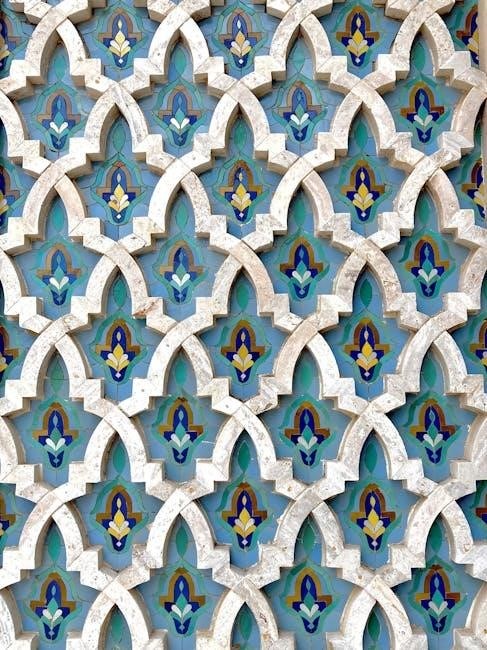
Bonus: Additional Colorways and Variations
Explore stunning variations like Marrakesh and Sandalwood for a modern twist on the Persian Tiles pattern. These colorways blend vibrant hues with earthy tones for a unique aesthetic. Discover free PDFs featuring these designs and get inspired by crochet communities sharing their personalized schemes. Perfect for adding a creative touch to your project!
Marrakesh and Sandalwood Colorway Inspirations
The Marrakesh colorway brings vibrant warmth, blending terracotta, golden yellows, and deep blues, reminiscent of Moroccan architecture. Sandalwood offers a softer, earthy palette with warm beiges, mauves, and muted greens, evoking a serene, natural beauty. These color schemes can be combined to create a unique, modern twist on the traditional Persian Tiles design. Both options add a sophisticated touch, allowing crafters to personalize their projects while maintaining the pattern’s cultural essence. These colorways inspire creativity and experimentation, making each finished blanket truly one-of-a-kind.
Exploring Personalized Color Schemes
Personalized color schemes allow you to infuse your Persian Tiles crochet project with unique flair. Start by selecting a base color that reflects your personal style, then add complementary shades for depth. Consider your home decor or favorite seasonal themes for inspiration. Experiment with bold contrasts or subtle gradients to create visual interest. Test swatches to ensure harmony between colors and adjust as needed. This creative freedom lets you craft a one-of-a-kind piece that truly represents your aesthetic. Don’t hesitate to mix and match for a design that’s all your own!
Final Note
Embark on the rewarding journey of creating Persian Tiles, where every stitch tells a story. This timeless design combines beauty and heritage, offering a satisfying crochet experience. Downloading the Persian Tiles Crochet Pattern PDF for free allows crafters to explore intricate motifs and vibrant colors. Start your project today and enjoy the meditative process of crafting something truly special!
The Rewarding Journey of Creating Persian Tiles
Crafting the Persian Tiles Crochet Pattern is a rewarding journey that combines creativity with precision. Each intricate motif, from octagons to triangles, offers a sense of accomplishment as they come together to form a stunning mosaic. The process allows you to connect with traditional Persian art while adding a modern twist. As you work through the pattern, you’ll experience the joy of transforming yarn into a vibrant, textured masterpiece. Whether gifting it or keeping it for yourself, the finished blanket becomes a cherished possession. Embrace the challenge and celebrate the beauty of handmade artistry.
